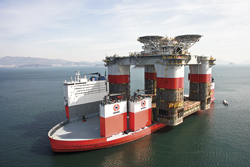 |
| The Goldeneye rig sits on a depleted North Sea gasfield where CO2 could be buried. Photo courtesy of Royal Dutch Shell. |
|
World Oil: Does its first cargo, the Jack/St Malo hull (Fig. 1), showcase the benefits of the Dockwise Vanguard?
Michel Seij: This cargo could have been carried on our existing Blue Marlin vessel, but that would have really stretched its capabilities and caused some issues. The Dockwise Vanguard is much better for this cargo.
WO: What advantages does the Dockwise Vanguard have over the Blue Marlin?
Seij: The Dockwise Vanguard has a bigger carrying capacity, so there is a significant increase in the deadweight tonnage that it can handle—117,000 tons, compared to 76,000 tons for the Blue Marlin. Also, the Dockwise Vanguard is better at carrying heavy cargoes with a high center of gravity.
The biggest difference is that on the Dockwise Vanguard, we can utilize the full deck line to support cargoes. That gives it an advantage when carrying ship-like structures, like FPSOs or vessels, and also other long structures like spar buoys. Dockwise Vanguard has a significant advantage over Blue Marlin, with respect to the length of cargo that you can support.
WO: What has made that possible?
Seij: The vessel is somewhat longer and wider at 275 m by 70 m, compared to 225 m by 63 m for Blue Marlin. But the biggest difference is that there is no conventional forecastle on the Dockwise Vanguard, which allows you to support a cargo all the way to the bow of the vessel and even beyond that, if there is some overhang.
WO: Can an overhang create problems?
Seij: For the vessel, itself, an overhang is not a problem. But it depends on the cargo. If you have a ship-shaped structure, the overhang is probably not an issue. If you have a very vulnerable cargo that is not allowed to come into contact with the water, then it’s obviously not an option.
WO: How is it possible to handle cargoes with a high center of gravity?
Seij: That’s possible, due to the size of the vessel. The width and depth of the vessel give a much better stability performance than, for instance, Blue Marlin.
WO: Are the Dockwise Vanguards moveable casings new technology?
Seij: Moveable casings are something you will see on other vessels, so that’s pretty straightforward. The configuration of having two casings in the port side, forward, is something new.
WO: What about new technology elsewhere?
Seij: One of the strengths of the vessel is that it doesn’t use a lot of new technology in the individual components. It is based on proven concepts and proven technology. From the point of view, of reliability, we thought it was quite important that we didn't take too much new technology onboard without a proven track record.
The uniqueness of the vessel is in the way these components are set up and used.
If you look at the propulsion train, we use widely employed Wärtsilä engines connected to a generator, so it’s a straightforward diesel electric plant. But the way that it’s set up with four engines, rather than only two or three, gives more flexibility.
WO: What does four engines bring you?
Seij: It gives redundancy when generating power, and also flexibility when setting the optimum utilization of the engines. This vessel will sail with a wide variety of drafts, and in very different conditions—carrying cargoes, mobilizing without cargoes, sailing at different speeds. So there is a very wide range of power requirements. With four generators of two different capacities onboard, you can always find an optimal setting for the engines.
WO: The vessel can carry deeper draft cargoes. Is that a big step forward?
Seij: Especially when it comes to semisubmersibles, the increased submerging draft is a big advantage, as our other vessels were using their submerging drafts to the limit. We’ve chosen to increase the draft to about 16 m of water above our main deck, compared to around 15 m on the Blue Marlin, because we expect that cargo drafts will increase, given the development of larger, fully integrated units.
WO: What is the vessel's next voyage?
Seij: We have two other voyages planned, both from South Korea to Norway. The vessel will transport the Goliat FPSO and then the Aasta Hansteen (gas field) spar platform. There is also a lot of discussions going on between other potential clients and Dockwise at the moment.
WO: What will the next generation of semisubmersible transport vessels look like?
Seij: They will probably be somewhat bigger, both in terms of the main dimensions and the submerging draft. But this vessel has been well received by clients, so if we build another vessel of this size, we will probably go for the same concept again. 
|
The author
MICHEL SEIJ is manager, engineering, at Dockwise. Having joined the company in 2001, he worked in various technical and operational positions before becoming manager of the Dockwise engineering team. Since 2010, he has been heavily involved in developing the Dockwise Vanguard. Mr. Seij trained as a naval architect at the Technical University, Delft. |
|



